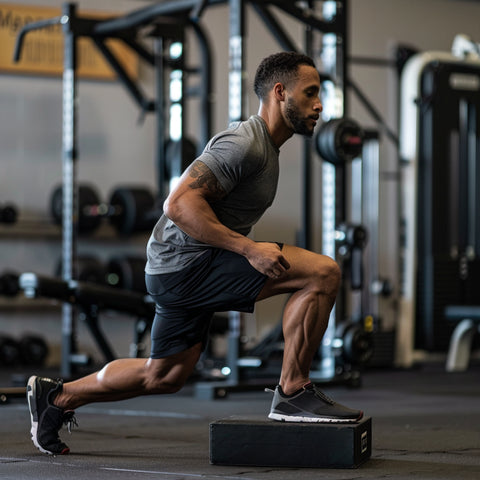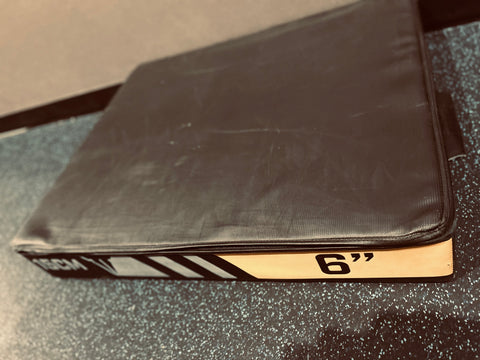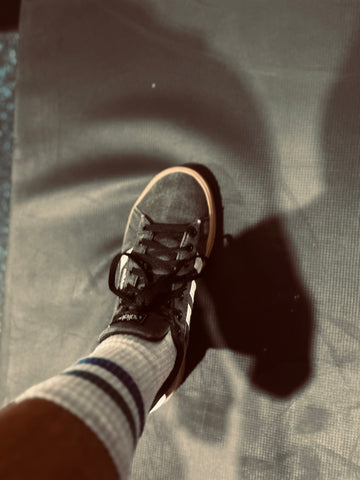
What if I told you that a deficit is better?
Okay well, not in all things.
A deficit in money? Not so hot.
A deficit in friendship? No, thank you.
A deficit reverse lunge? Now we’re talking!
You see, deficit training is an exercise technique that causes you to gain range of motion (ROM) by actually extending how far you move. When you do this, you get crazy muscle gains because NOW your body is working THAT much harder!
A deficit reverse lunge does exactly that.
By elevating your front foot, you increase the ROM for the lunge itself, basically making the deficit reverse lunge…a lunge on steroids!
Today, we’ll explore everything you need to know about the deficit reverse lunge, including:
- How To
- 8 Pro Tips
- Muscles Worked
- Benefits
- FAQs
How to Do a Deficit Reverse Lunge
Here’s how to do a deficit reverse lunge in 7 easy steps!
1) First, set up a way to elevate your front foot! This could involve using weight plates or a plyometric box at the gym. Whatever you use, the elevation height should be around 3-8 inches.

2) Next, stand on the elevated surface with both feet shoulder-width apart. This is your starting position!
3) Bring your left foot back behind you. With the ball of your foot touching the ground, bend your left knee until it hovers just over the floor.
4) When you do this, your front, right knee will also bend. For a typical lunge, you’d expect this front knee to bend close to a 90-degree angle, but for a deficit reverse lunge, the angle will become smaller as you increase your ROM.
5) Your torso should lean forward just slightly to enhance balance while also maintaining a flat back.
6) Now lift your back leg off the ground and back up to the elevated surface.
7) Repeat for the desired amount of reps. Then, switch sides.


See that? Nothing too crazy.
Just a lunge starting from a higher position.
BUT the leg and glute gains you get from the deficit reverse lunge will be crazy!
8 Deficit Reverse Lunge: Pro Tips!
Now that we know the basic move, let’s make things a bit more complicated. These pro tips will make sure you’re working ALL the right muscles during your deficit reverse lunges!
Deficit Reverse Lunge Pro Tip #1: How High to Go
Whether you choose to stack weight plates on top of one another or you have a solid plyometric box, considering the height of the elevated surface you use is one of the first questions people ask.
3-8 inches is typically recommended, BUT to really know which height is for you, hip mobility is what we have to consider.
Here’s what you really want to look for.
If the elevated surface brings your front knee up so high, that your butt starts to tuck under you, causing a posterior pelvic tilt, then this is when you know you’ve gone too high!
Instead, you should be able to perform a deficit reverse lunge without your butt tilting inward. This will enable you to keep a flat back and avoid impingement during the motion.
Deficit Reverse Lunge Pro Tip #2: Slowly Increase the Height
The higher you go, the harder the lunge will be because you are increasing the deficit.
As we just pointed out, you obviously don’t want to go so high that you can cause a posterior pelvic tilt and potential lower back pain.
So, find that sweet spot between a challenging height and good form!
As you’re starting out with the deficit reverse lunge, begin with a lower platform. Then, as you gain confidence, gradually increase the height.
This will build your strength and stamina up to your ideal height!
Deficit Reverse Lunge Pro Tip #3: How Far to Step Back
Depending on how far you step back into the lunge, you can favor different muscles. So, you can decide which one works for you!
1) For a quad-dominant deficit reverse lunge: You don’t need to step back as far. This places more emphasis on the front knee and engages your quads more so than the glutes.
2) For a glute-dominant deficit reverse lunge: You will need to step back a bit further. This places less emphasis on the front knee and more on hip flexion, which causes your glutes to get involved!
Deficit Reverse Lunge Pro Tip #4: Push Off the Back Leg
Once you've brought your leg back behind you and bent your knee toward the ground, you’re gonna want an explosive push off the back leg to propel this leg back up to the starting position.
Think about pushing the ball of your foot into the ground and then using this to push the leg back into the air.
Engaging your working glute muscle during this push also helps with extra glute activation!
Deficit Reverse Lunge Pro Tip #5: Weight Distribution for Legs
During the deficit reverse lunge, think about distributing most of your weight (60-80%) to your front leg and less of the weight (40-20%) to your back leg.
This will help keep the working leg…WORKING!
Deficit Reverse Lunge Pro Tip #6: Lean Forward
The slight forward lean of the torso during the deficit reverse lunge actually increases hip flexion and helps to engage your glutes even more during this exercise.
Your back should not be straightened out, and your butt should not be tucked under.
Deficit Reverse Lunge Pro Tip #7: Add Dumbbells
Turn your deficit reverse lunge into a dumbbell deficit reverse lunge! It may be a mouthful, but adding weight will take this exercise up a notch and continue to get you those leg gains!
You could start light with a single dumbbell or kettlebell held with both hands.
Or you could keep it more balanced by using a dumbbell or kettlebell in each hand.
This approach, as opposed to loading a barbell up on your shoulders, enables you to make the lunge harder with weights while also keeping a form that consistently targets your glutes.
Deficit Reverse Lunge Pro Tip #8: Brace Your Core
Keeping a tight core during the motion of a reverse deficit lunge will help you keep good form, engage your glutes, and maintain that slightly forward lean!
So, there you have it. With these 8 pro tips, your reverse deficit lunges will have you looking like a boss both at the gym with that meticulous form AND at home with those hella-built glutes!
Deficit Reverse Lunge Benefits

Once you master these pro tips for the reverse deficit lunge, you’ll be well on your way to getting ALL the benefits of this exercise!
What are those benefits?
Glad you asked. Because there are tons! But today, we’ll focus on 7.
1. Improve Your Balance
This exercise naturally challenges anyone’s balance–even the most fit–and the deficit makes the balance even harder!
By the way, if balancing in a reverse deficit lunge is hard for you, start out with a regular lunge and then eventually work your way up to a reverse deficit lunge.
Once you do, you’ll find the balance even more difficult during the motion but the benefits are improved balance overall!
2. Show Those Knees Some Love
One reason I like the reverse deficit lunge is that it takes it easy on those knees!
Let’s face it: Knees work hard when you work out, especially during regular lunges, forward lunges, and walking lunges. If your knees tend to act up when you do a regular lunge, the deficit reverse lunge may be a good alternative exercise for you!
Here’s why: When you go down into a forward lunge, your quad and knee immediately take the brunt of your weight, adding stress to your knee joint during the exercise.
When you reverse it, this front knee stays put while the emphasis now shifts to your glutes and hamstring.
3. Work Those Glutes
If you're looking to strengthen your glutes OR add to their size for personal aesthetics, the reverse deficit lunge is a great option for you!
The greater ROM that takes place due to the deficit in this exercise specifically activates the glutes–even more so than with a regular lunge.
Your lower glutes, in particular, will get a good stretch during this motion.
4. Focus On One Leg At a Time
Because the deficit reverse lunge is inherently a single-leg workout, you automatically weed out any strength discrepancies between your legs as you work one leg at a time.
If you notice one leg is weaker than the other, you can target this leg specifically in your workouts to help balance out the strength between your glutes and legs on each side.
5. Get More Bang for Your Buck Without the Weight
If you’re anything like me, you hate adding weight to your lunges because you know it’s gonna be extra painful.
Reverse deficit lunges are a great way to boost the difficulty of your lunge without having to hoist a huge dumbbell.
6. Do It At Home
Leg exercises from home can get tricky because the gym has so many fancy leg machines. This one’s easy to replicate at home.
All you need is something secure to stand on.
And adding weight is easy too if you have some dumbbells lying around.
7. Get Better Athletic Performance
Since reverse deficit lunges are a level up from a regular lunge, they help athletes even more with that explosive athletic performance.
So, whether it’s jumping, running, or some other hip flexion movement, reverse deficit lunges will enhance these motions
Deficit Reverse Lunge Muscles Worked
Quads
As you descend and raise back up, your quads will engage, making the reverse deficit lunge a great quad exercise!
As I mentioned before, the quad activation depends on how far back you bring your back leg. So, by keeping your back leg closer and your front knee bent more, your quads get further activated with this exercise.
Glutes
Your glutes fire near the bottom of this motion. To lift your leg back up, it’s up to that working glute!
As I mentioned, you can bring your back leg even further back, creating less bend in your front knee, in order to further emphasize the glute in this exercise.
Some other important muscles that get activated during this exercise are:
Core
More Exercise Resources Just Like This!
We like providing people with the best exercise resources out there! So, if this guide on how to perform the deficit reverse lunge is helpful to you, definitely check out some of our other great workout guides and tips!
Articles
“6 Best Hamstring Exercises to Bulk Up Those Legs”
“Back Extensions for Glutes: Unlock Glute Gains With This Exercise”
“Glute And Hamstring Stretches For Lower Back Pressure Relief”
Videos
“Best Exercises For Gluteus Medius & Minimus (TOP 4)”
“Glute Activation Exercises From Beginner To Advanced [Ranked]”
“Gluteus Medius Exercises Before And After [LOWER BACK PAIN KEY]”
If you want more of a guided workout approach, check out Back of Steel, our lower back strengthening program.
This is a 15-minute, 3-day-a-week program that helps you prevent lower back:
- flare-ups
- spasms
- AND pain
With your purchase of Back of Steel, you’ll get:
- Exclusive written and video content ALL about back strength!
- Detailed exercise instructions, including sets, tempos, and reps!
- Best tips for training your lower back and making it ironclad!
Learn more about Back of Steel HERE.
Reverse Deficit Lunge FAQs
How high should I elevate my foot for the deficit reverse lunge?
For a deficit reverse lunge, you should aim to elevate your foot 3-8 inches, focusing on form rather than height. The higher you go, the harder the move.
BUT if your butt starts to tuck in, this could be a sign that you’ve gone too high.
What does deficit reverse lunge work?
The deficit reverse lunge primarily works your glutes and quads while also firing up your hamstrings, abductors, adductors, and core.
Are reverse deficit lunges good for glutes?
Reverse deficit lunges are great for your glutes because, with the increased range of motion, you get more hip flexion during the exercise which = more glute activation!
What is the difference between deficit reverse lunge and Bulgarian split squat?
A deficit reverse lunge is more static than a Bulgarian split squat because you are consistently moving your back leg. A Bulgarian split squat involves you staying in the same position while squatting.
In the deficit reverse lunge, you start on an elevated surface and lunge with your leg behind you. A Bulgarian split squat involves you starting with your back foot elevated.
[1] https://www.sciencedirect.com/science/article/abs/pii/S1360859218304546


